I made an algorithm to measure an object using a reference, like this:
The reference is the frame and the other (AOL) is the desired object. My code obtained this result:
But the real AOL is 78.6. This is because of the perspective/angle of photograph. So I used in my code Deep Learning and I obtained the the reference and AOL mask, and I made a simple calculation based on the number of pixels for each mask to obtain AOL area (cm²), once I know the actual size of the reference. I tried to correct the angle/perpective based on the reference and I used the reference mask:
I tried to calculate quadrangle vertices based on the reference mask to correct the perspective. I created this code based on this reference Perspective correction in OpenCV using python:
# import the necessary packages
from scipy.spatial import distance as dist
from imutils import perspective
from imutils import contours
import numpy as np
import imutils
import cv2
import math
import matplotlib.pyplot as plt
# get the single external contours
# load the image, convert it to grayscale, and blur it slightly
image = cv2.imread("./ref/20210702_114527.png") ## Mask Image
gray = cv2.cvtColor(image, cv2.COLOR_BGR2GRAY)
gray = cv2.GaussianBlur(gray, (7, 7), 0)
# perform edge detection, then perform a dilation + erosion to
# close gaps in between object edges
edged = cv2.Canny(gray, 50, 100)
edged = cv2.dilate(edged, None, iterations=1)
edged = cv2.erode(edged, None, iterations=1)
# find contours in the edge map
cnts = cv2.findContours(edged.copy(), cv2.RETR_EXTERNAL,
cv2.CHAIN_APPROX_SIMPLE)
cnts = imutils.grab_contours(cnts)
# sort the contours from left-to-right and initialize the
# 'pixels per metric' calibration variable
(cnts, _) = contours.sort_contours(cnts)
pixelsPerMetric = None
orig = image.copy()
box = cv2.minAreaRect(min(cnts, key=cv2.contourArea))
box = cv2.cv.BoxPoints(box) if imutils.is_cv2() else cv2.boxPoints(box)
box = np.array(box, dtype="int")
# order the points in the contour such that they appear
# in top-left, top-right, bottom-right, and bottom-left
# order, then draw the outline of the rotated bounding
# box
box = perspective.order_points(box)
cv2.drawContours(orig, [box.astype("int")], -1, (0, 255, 0), 2)
# loop over the original points and draw them
for (x, y) in box:
cv2.circle(orig, (int(x), int(y)), 5, (0, 0, 255), -1)
print('Box: ',box)
cv2.imshow('Orig', orig)
img = cv2.imread("./meat/sair/20210702_114527.jpg") #original image
rows,cols,ch = img.shape
#pts1 = np.float32([[185,9],[304,80],[290, 134],[163,64]]) #ficou legal 6e.jpg
### Coletando os pontos
pts1 = np.float32(box)
### Draw the vertices on the original image
for (x, y) in pts1:
cv2.circle(img, (int(x), int(y)), 5, (0, 0, 255), -1)
ratio= 1.6
moldH=math.sqrt((pts1[2][0]-pts1[1][0])*(pts1[2][0]-pts1[1][0])+(pts1[2][1]-pts1[1][1])*(pts1[2][1]-pts1[1][1]))
moldW=ratio*moldH
pts2 = np.float32([[pts1[0][0],pts1[0][1]], [pts1[0][0]+moldW, pts1[0][1]], [pts1[0][0]+moldW, pts1[0][1]+moldH], [pts1[0][0], pts1[0][1]+moldH]])
#print('cardH: ',cardH,cardW)
M = cv2.getPerspectiveTransform(pts1,pts2)
print('M:', M)
print('pts1:', pts1)
print('pts2:', pts2)
offsetSize= 320
transformed = np.zeros((int(moldW+offsetSize), int(moldH+offsetSize)), dtype=np.uint8)
dst = cv2.warpPerspective(img, M, transformed.shape)
plt.subplot(121),plt.imshow(img),plt.title('Input')
plt.subplot(122),plt.imshow(dst),plt.title('Output')
plt.show()
And I got this:
No perspective correction. I have a lot of information like vertices, the correct size of the reference. Is it possible to do a mathematical correction based on quadrangle vertices, like a regression? Not necessarily correcting the image directly, unless there is a good method to correct the perspective image. Or maybe a different approach based on math? Thanks for your patience.
For Christoph:
This is the result position too:
pts1: [[ 9. 51.]
[392. 56.]
[388. 336.]
[ 5. 331.]]





